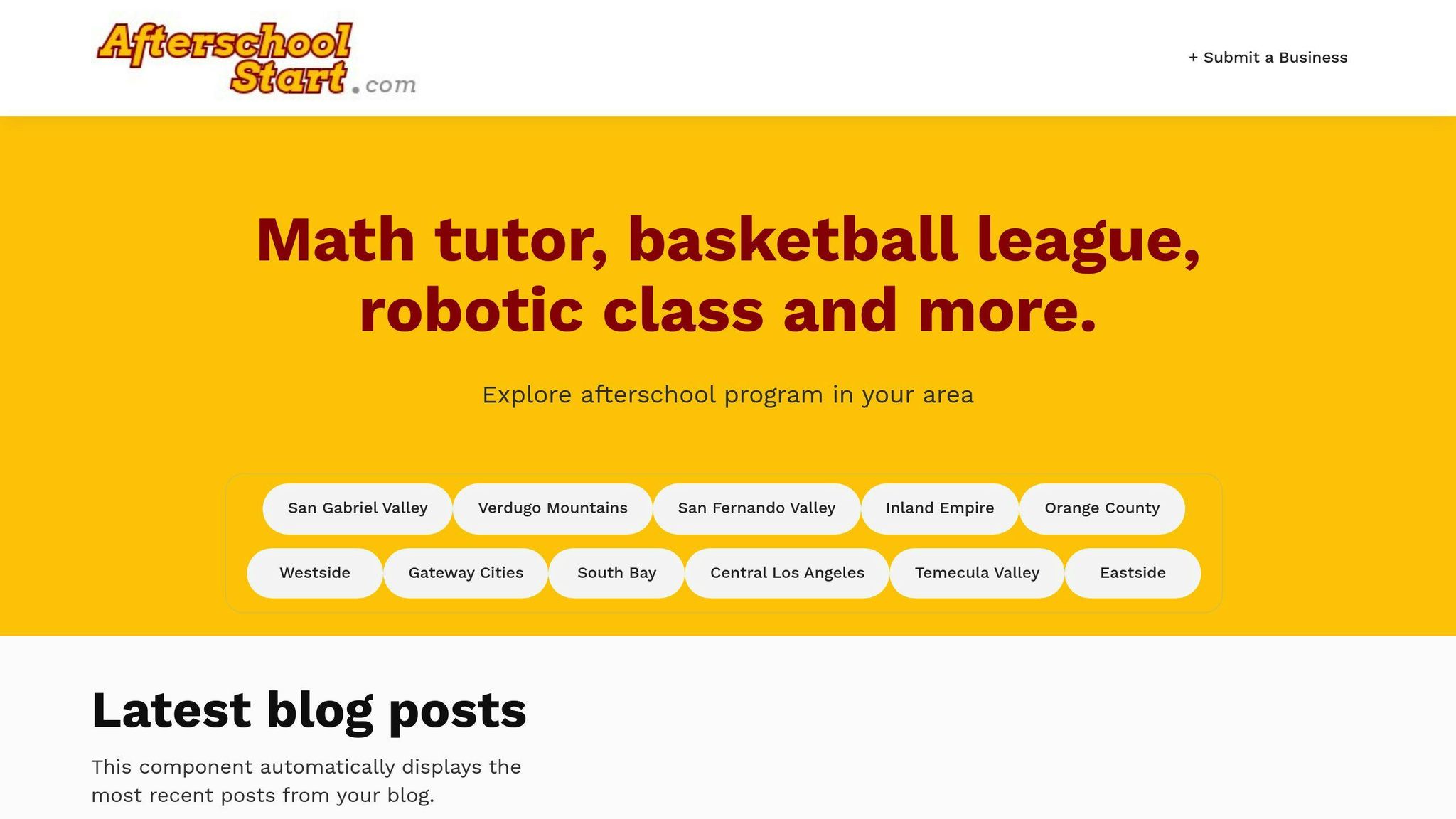Planning afterschool activities can be stressful for busy parents, but it doesn't have to be. Here's how you can simplify your routine and keep your kids engaged:
- Use Digital Tools: Apps like Cozi, FamilyWall, and Google Calendar streamline scheduling with features like shared calendars and real-time updates.
- Leverage Local Resources: Community centers and programs like the YMCA or Boys & Girls Clubs offer affordable, structured activities.
- Create Weekly Templates: Plan balanced schedules that include core activities, family time, and downtime for flexibility.
- Explore Program Directories: Use online directories to find activities that fit your child's interests, schedule, and budget.
- Balance Activities with Downtime: Avoid over-scheduling by leaving room for rest and unstructured play.
Quick Tip: Start with a shared calendar to keep everyone on the same page, and prioritize balance to make life easier for the whole family.
Creating a Healthy After School Routine for Your Child
1. Use Digital Tools for Easier Scheduling
Managing afterschool activities while balancing work and family life can feel overwhelming. Thankfully, digital tools can simplify scheduling and help turn chaos into a smoother routine.
Scheduling Apps
Apps like Cozi, FamilyWall, and Google Calendar are designed to make family schedules easier to manage. Here's a quick breakdown of what they offer:
| App Name | Key Features | Best For |
|---|---|---|
| Cozi | Color-coded calendars, shared grocery lists, real-time updates | Families needing an all-in-one organizer |
| FamilyWall | Activity tracking, schedule sharing, in-app messaging | Families with multiple caregivers |
| Google Calendar | Sync across devices, easy sharing, app integrations | Families already using Google services |
These tools allow you to keep everyone on the same page, whether it's tracking soccer practice or planning family dinners.
Prioritizing Activities
Once you’ve chosen a scheduling app, use it to organize activities into categories. Focus on core commitments like homework and sports, enrichment activities that support your child’s interests, and flexible options that can be shifted around if needed. This approach ensures your child’s schedule stays balanced and manageable.
Time Blocking for Structure
Time blocking is a great way to bring structure to a packed schedule. Here's an example of how to break it down:
| Time | Activity Type | Benefits |
|---|---|---|
| 3:00-4:00 PM | Homework | Builds a consistent study habit |
| 4:00-5:00 PM | Structured Activity | Encourages skill development |
| 5:00-6:00 PM | Family Dinner | Strengthens family connections |
Tip: Use app reminders to help your family transition smoothly between activities.
While these digital tools can simplify your day-to-day planning, don’t forget to explore local community resources for even more activity options.
2. Use Local Community Resources
Local community resources can simplify afterschool planning for busy parents by offering affordable, structured activities. These programs provide children with a safe environment to learn and grow, allowing parents to focus on their work schedules.
Community Centers
Community centers like the YMCA are a hub for a variety of programs, including sports, arts, and academic support. They offer flexible schedules and transportation options, making them a convenient choice for working families.
| Program Type | Activities Offered | Benefits |
|---|---|---|
| Sports & Fitness | Basketball, swimming lessons, dance | Promotes physical health and teamwork |
| Arts & Culture | Theater, music lessons, visual arts | Encourages creativity and self-expression |
| Academic Support | Homework help, STEM workshops | Boosts learning and problem-solving skills |
Local Afterschool Programs
Organizations like the Boys & Girls Clubs of America provide structured activities during critical afterschool hours (3:00 PM - 6:00 PM). These programs are known for enhancing academic performance and social skills and often include financial aid options, making them accessible to families across income levels.
"Children who participate in high-quality afterschool programs show significant improvements in academic performance and social skills" - National Institute of Child Health and Human Development
When choosing an afterschool program, keep these factors in mind:
| Selection Criteria | What to Look For |
|---|---|
| Program Quality | Trained staff, structured curriculum, good reviews |
| Accessibility | Convenient location, transportation, hours |
| Cost | Fees, scholarships, payment flexibility |
| Activity Variety | A mix of educational, physical, and creative options |
According to the Afterschool Alliance, 10.2 million children (about 18% of school-age kids) in the U.S. participate in afterschool programs. This highlights how many families rely on these resources to manage busy schedules.
3. Use Weekly Activity Templates
Creating a weekly activity template can help busy parents manage their family's schedule more efficiently. While local resources offer great activity options, a template ensures these activities fit smoothly into your routine. It’s a simple way to cut down on the mental juggling of multiple commitments.
Why Weekly Templates Work
Weekly templates provide structure, improve time management, and help establish predictable routines for the whole family. A good template balances essential tasks with room for flexibility.
| Time Block | Purpose | Benefits |
|---|---|---|
| Core Activities & Buffer Time | Homework, sports practice, transitions | Maintains consistency and reduces last-minute stress |
| Family Time | Meals, shared activities | Builds stronger family connections |
| Downtime | Rest, free play, relaxation | Encourages balance and personal growth |
Using digital tools can make these templates even easier to manage. They allow you to quickly adjust plans and coordinate with other family members, saving time and effort.
Preparing for the Unexpected
Life happens, so it’s smart to leave some wiggle room in your schedule. Add 30-minute buffers between activities, have backup plans for weather-sensitive events, and keep a list of alternative activities ready to go.
Make it a habit to review and tweak your template every month. This helps you account for seasonal changes or shifts in family priorities while keeping the core structure intact.
Pro Tip: Use color-coding in your digital calendar to make your schedule easier to follow. Assign colors like blue for sports, green for school-related activities, and yellow for family time. This visual system can help both parents and kids stay on track.
Once your weekly template is up and running, you can further streamline your planning by checking out detailed afterschool program directories.
4. Use Afterschool Program Directories
Finding afterschool activities for your child doesn't have to be a time-consuming task. Directories for afterschool programs make it easier by offering a one-stop resource for local activities tailored to your child's interests and your schedule.
Afterschool Program Directory

This directory serves as a go-to database for afterschool activities, neatly organized by type - like academics, sports, or arts - and filtered by location, schedule, cost, and age group. Its smart search tools help you quickly find activities that fit your child’s needs. For busy parents, this eliminates the hassle and guesswork of finding well-matched, enriching programs.
Key Features
The directory offers tools to narrow down your search, allowing you to filter programs based on:
- Location: Easily find activities near your home or your child’s school.
- Schedule: Match program times with your availability.
- Cost: Look for options that fit your budget, including those offering financial assistance.
- Age Group: Ensure programs are suitable for your child’s developmental stage.
Free listings let you explore a variety of options, while premium listings often include extra details like parent reviews and full schedules, making it easier to make informed choices.
5. Balance Activities with Downtime
Striking the right balance between planned activities and free time is important for your child's growth and overall well-being. Adding downtime to your schedule not only gives your child a chance to recharge but also makes planning less stressful by easing the need to pack every moment with structured events.
Avoid Over-Scheduling
Overloading your child's schedule can lead to signs like exhaustion, stress, slipping grades, or a loss of interest in activities. To avoid this, you can use time blocking to set aside dedicated periods for rest and play. Aim to leave at least two weekday afternoons open for unstructured play or relaxation.
Mix of Activities
Pick activities that encourage physical, creative, social, and academic growth. Some examples include:
- Physical: Soccer or dance classes
- Creative: Painting or music lessons
- Social: Team sports or group activities
- Academic: STEM workshops or similar programs
Involve your child in choosing their activities to ensure they’re excited about what they’re doing. At the same time, set clear boundaries to avoid overloading their schedule.
A scheduling app can help you track activities and ensure you're keeping a good balance. By blending activities with downtime, you can create a schedule that supports your child's development while keeping things manageable for the whole family.
Conclusion: Stress-Free Activity Planning for Parents
Managing family schedules doesn’t have to be overwhelming, thanks to digital tools that help you stay organized. While structured activities offer great opportunities for kids, careful planning ensures they fit smoothly into your packed calendar.
Here are some tips to keep things running smoothly:
- Use digital tools to organize and share family calendars.
- Take advantage of local resources for nearby programs and activities.
- Create weekly schedules that allow flexibility for surprises.
- Explore program directories to find activities that suit your kids.
- Prioritize downtime to keep everyone refreshed.
The goal isn’t to pack every minute of the day - it’s to create a routine that works for your family. Start with something simple, like using a shared calendar, and gradually build from there. This step-by-step approach helps you set up a routine that’s easy to manage and beneficial for everyone.


